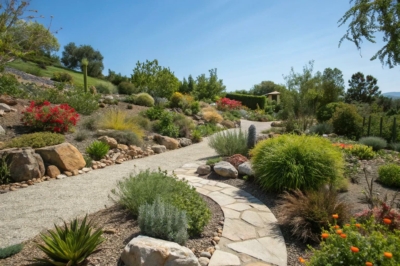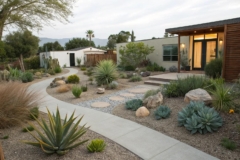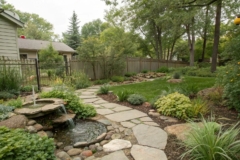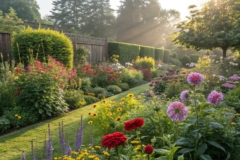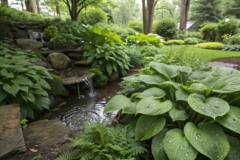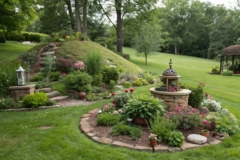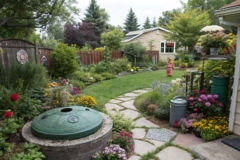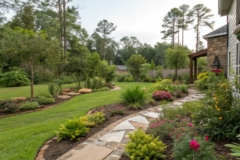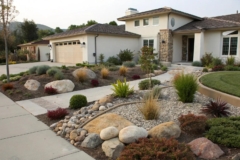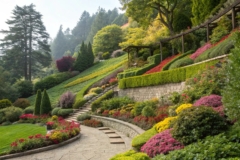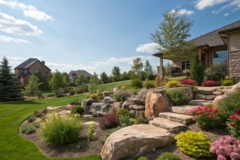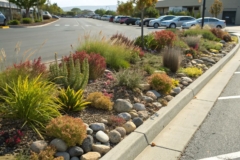1. Incorporate Decorative Rocks
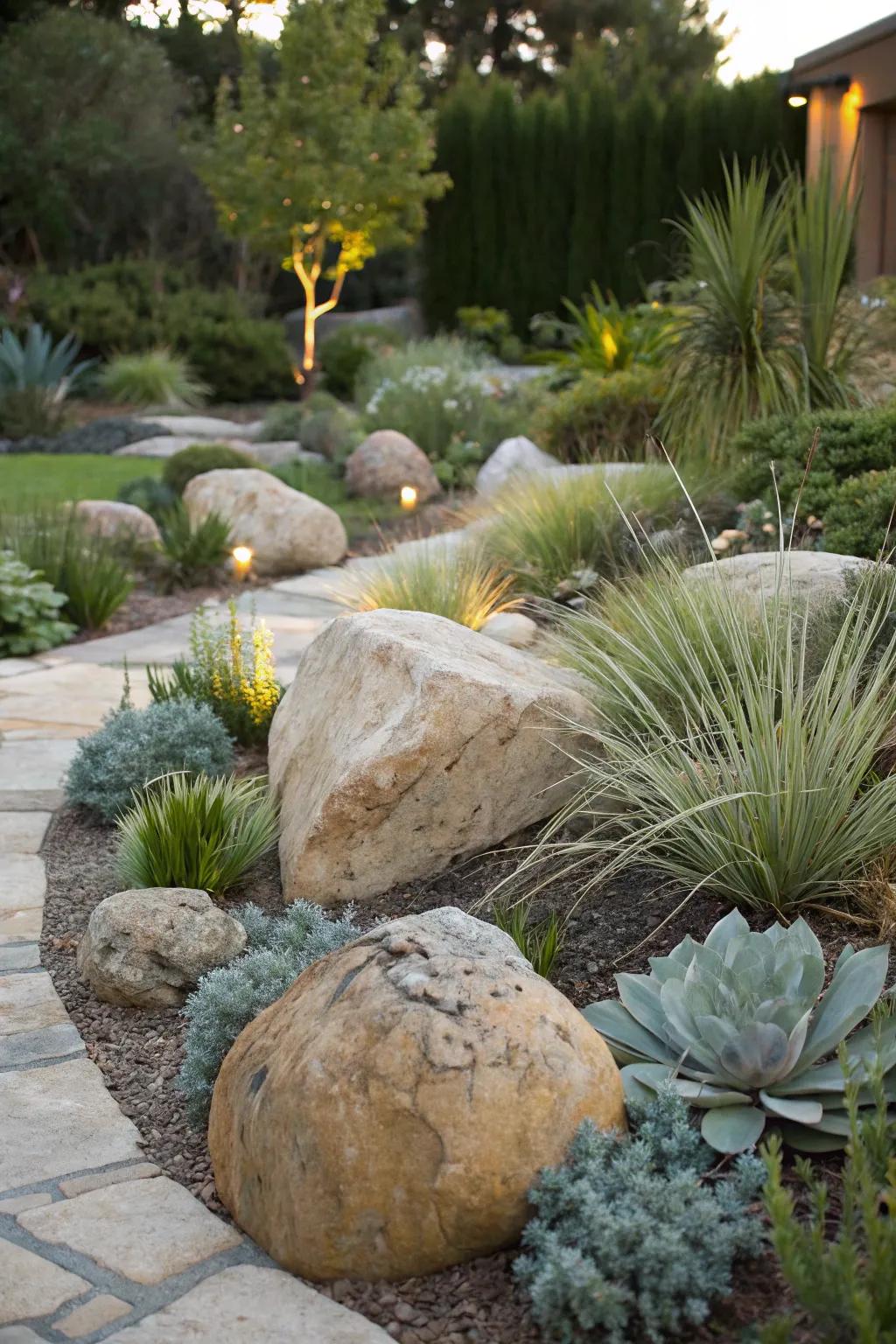
Accent your garden with decorative rocks for added texture and flair. They make my garden feel like a natural art piece while requiring zero water.
Explore these options:
- Natural Polished Pebbles: Enhance your garden’s texture with these smooth, polished pebbles for a sophisticated look.
- Large River Rocks: Add rustic charm to your landscape with these durable and weather-resistant river rocks.
- Garden Rock Lights: Illuminate your pathway elegantly with rock-shaped solar lights, merging style with functionality.
2. Embrace Minimalism
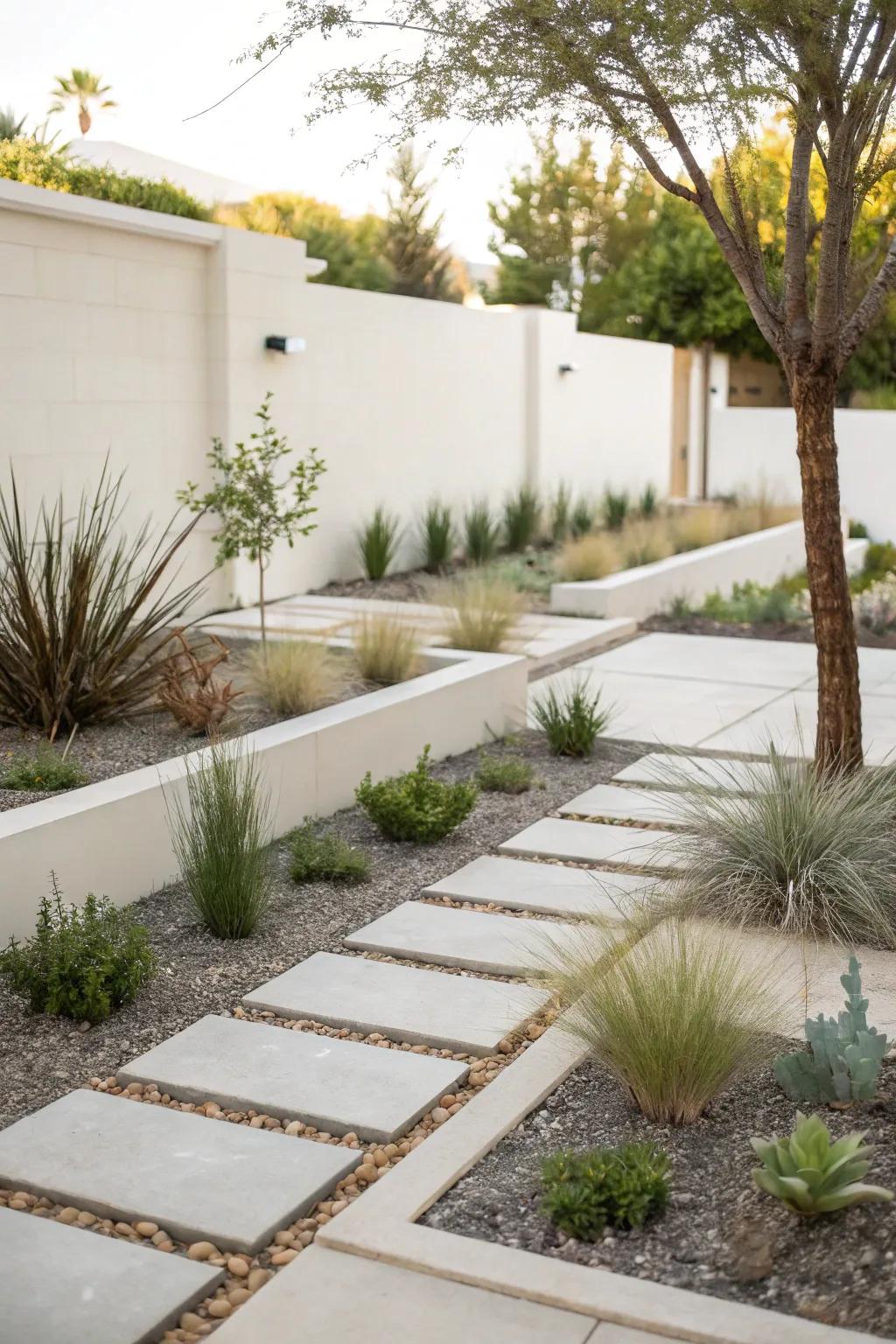
Minimalist designs can be striking with fewer plants and clean lines. My minimalist garden is a testament to ‘less is more’ in creating a peaceful retreat.
A few things you might like:
- Outdoor Solar Pathway Lights: Illuminate your minimalist garden effortlessly and sustainably with sleek solar-powered pathway lights.
- Decorative Gravel for Landscaping: Enhance your garden’s minimalistic appeal with decorative gravel, adding texture and elegance.
- Drought Tolerant Grass Seeds: Cultivate a lush, eco-friendly garden with easy-to-grow, drought-resistant grass seeds.
3. Use Permeable Pavers
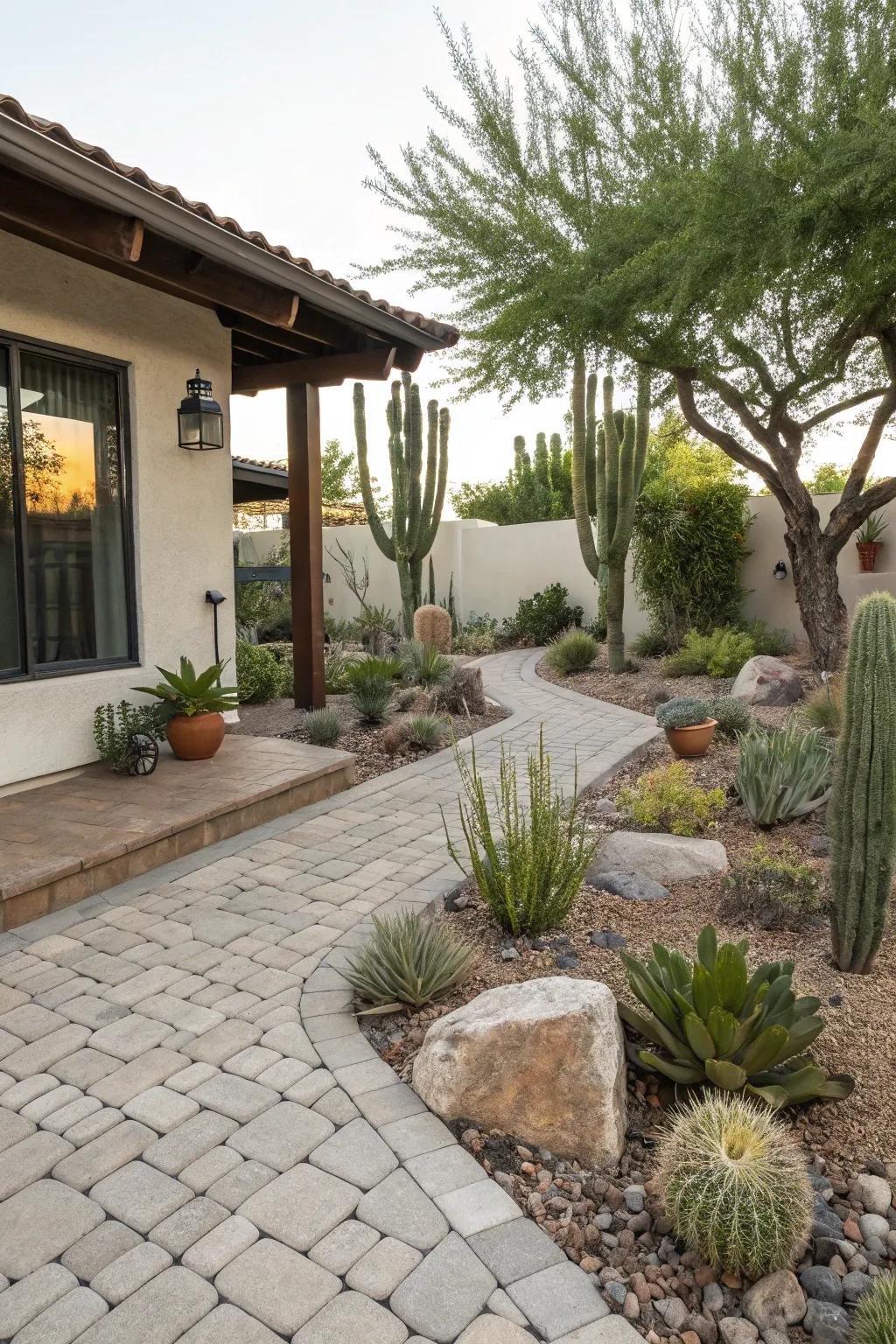
Permeable pavers allow water to seep through, reducing runoff. They form the base of my patio, blending functionality with style.
Some ideas to consider:
- Interlocking Permeable Paver Stones: Enhance your patio with these stylish paver stones, reducing runoff, and adding durability.
- Gravel for Paver Foundations: Use high-quality gravel to support pavers, ensuring effective drainage and stability.
- Landscape Edge Restraints: Maintain neat, defined paths with flexible edge restraints, suitable for various paving projects.
4. Install Solar Lighting
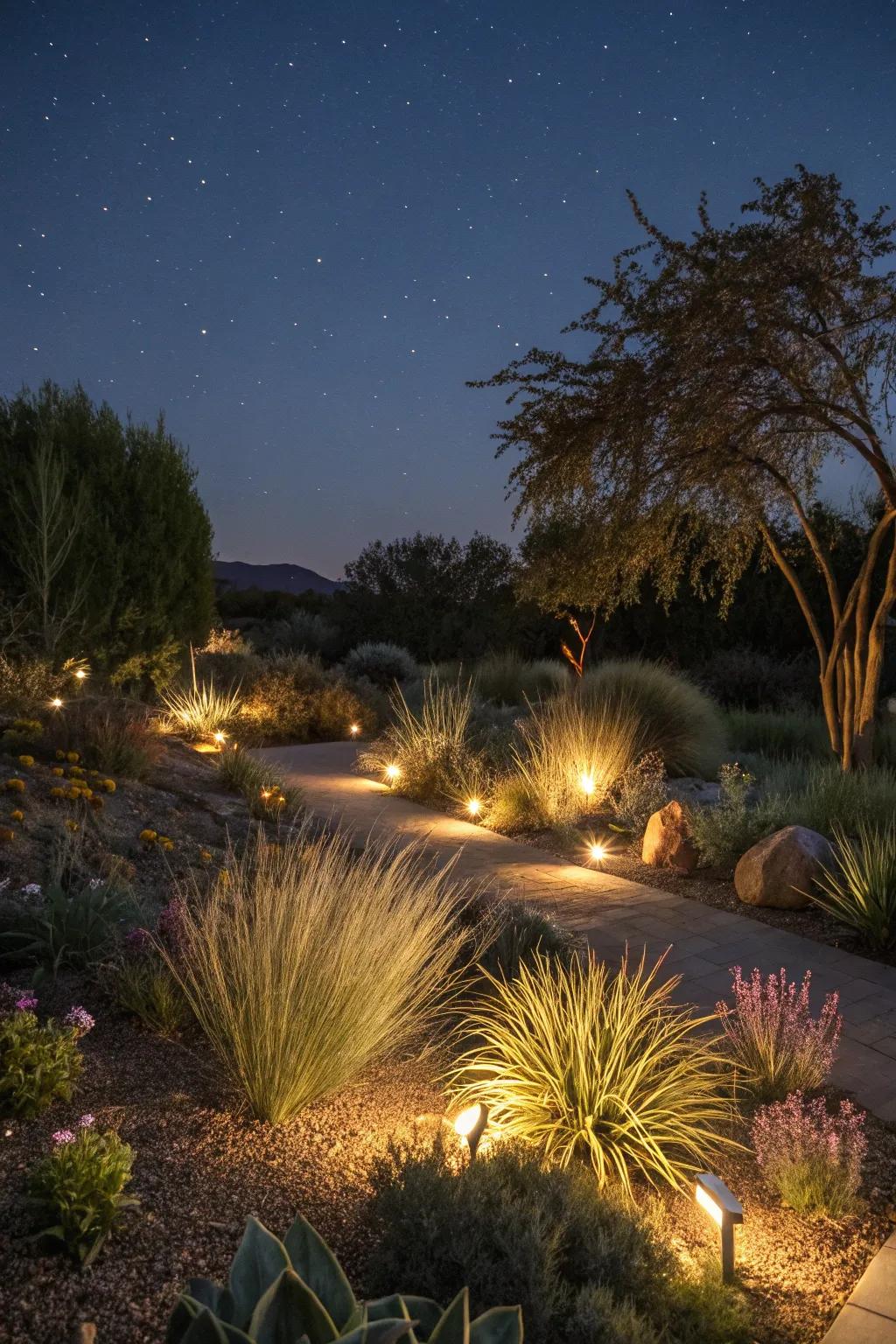
Solar lights add ambiance without increasing utility costs. My garden comes alive at night with eco-friendly illumination.
You might like:
- Outdoor Solar Pathway Lights: Illuminate your garden pathways with energy-efficient solar lights for a charming nighttime glow.
- Solar Spotlights for Landscape: Highlight beautiful garden features with adjustable solar spotlights for stunning evening aesthetics.
- LED Solar Garden Lights: Install LED solar garden lights to enjoy ambient beauty without increased electricity bills.
5. Create Gravel Pathways

Gravel pathways are not only cost-effective but also fantastic for reducing water use. In my backyard, these paths lead through vibrant patches of succulents and offer a rustic charm.
Maybe worth checking out:
- Garden Pathway Gravel: Transform your garden with this eco-friendly gravel, perfect for durable and attractive pathways.
- Landscape Edging Stones: Define your gravel paths beautifully with these versatile and durable landscape edging stones.
- Succulent Variety Pack: Enhance your pathway’s charm with an array of drought-resistant succulent plants.
6. Create a Rock Garden
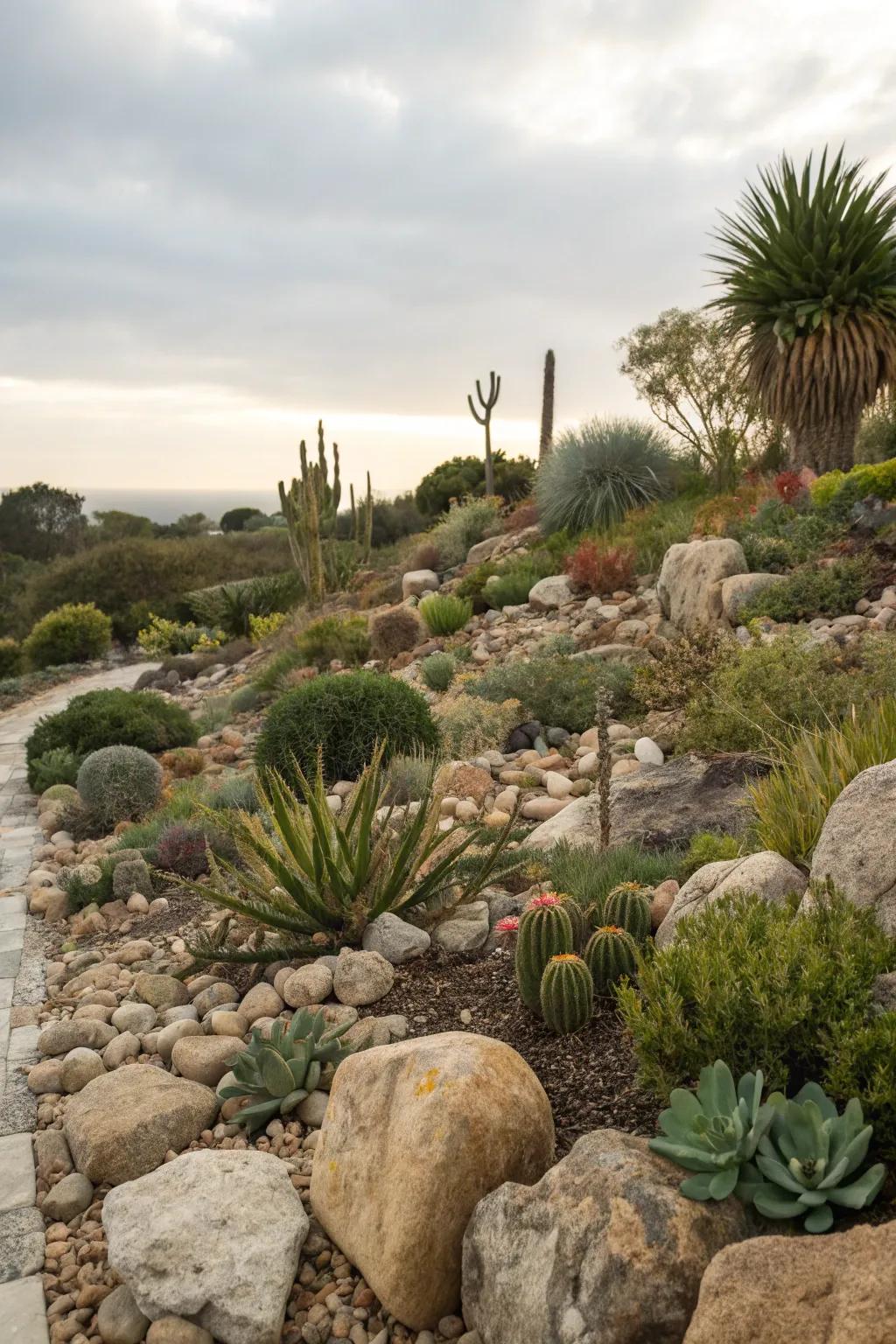
Rock gardens combine natural beauty with low water needs. I love how they bring a rugged charm to my landscape.
Possibly helpful picks:
- Decorative Garden Pebbles: Enhance your rock garden’s visual appeal with smooth, colorful pebbles. Add texture effortlessly.
- Drought-Tolerant Plant Seeds: Plant these seeds for a vibrant, water-efficient garden. Perfect for sustainable landscaping.
- Landscape Fabric: Prevent weed growth and maintain soil moisture with durable landscape fabric. Easy to install.
7. Incorporate Cactus
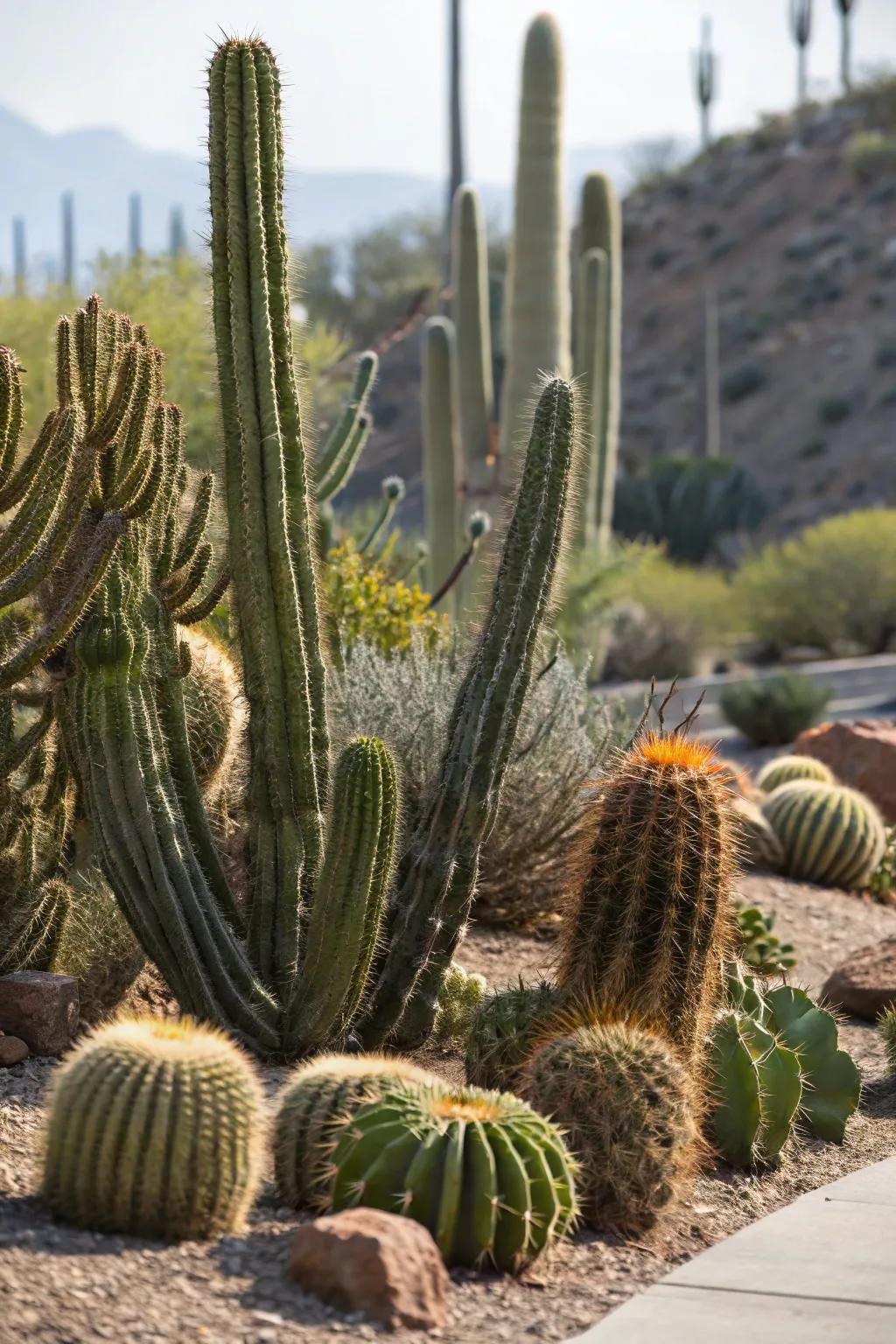
Cacti are perfect for adding a desert vibe with minimal water needs. Their unique forms make them a standout feature in any garden.
Try these:
- Assorted Live Cactus Collection: Brighten your garden with this variety of low-maintenance, drought-tolerant live cacti. Perfect for beginners.
- Decorative Cactus Pebble Mulch: Enhance your landscape aesthetics with decorative pebbles while improving cactus soil moisture retention.
- Outdoor Cactus Fertilizer: Boost your cacti’s growth with this specially formulated, easy-to-use cactus fertilizer for thriving plants.
8. Plant Succulent Gardens
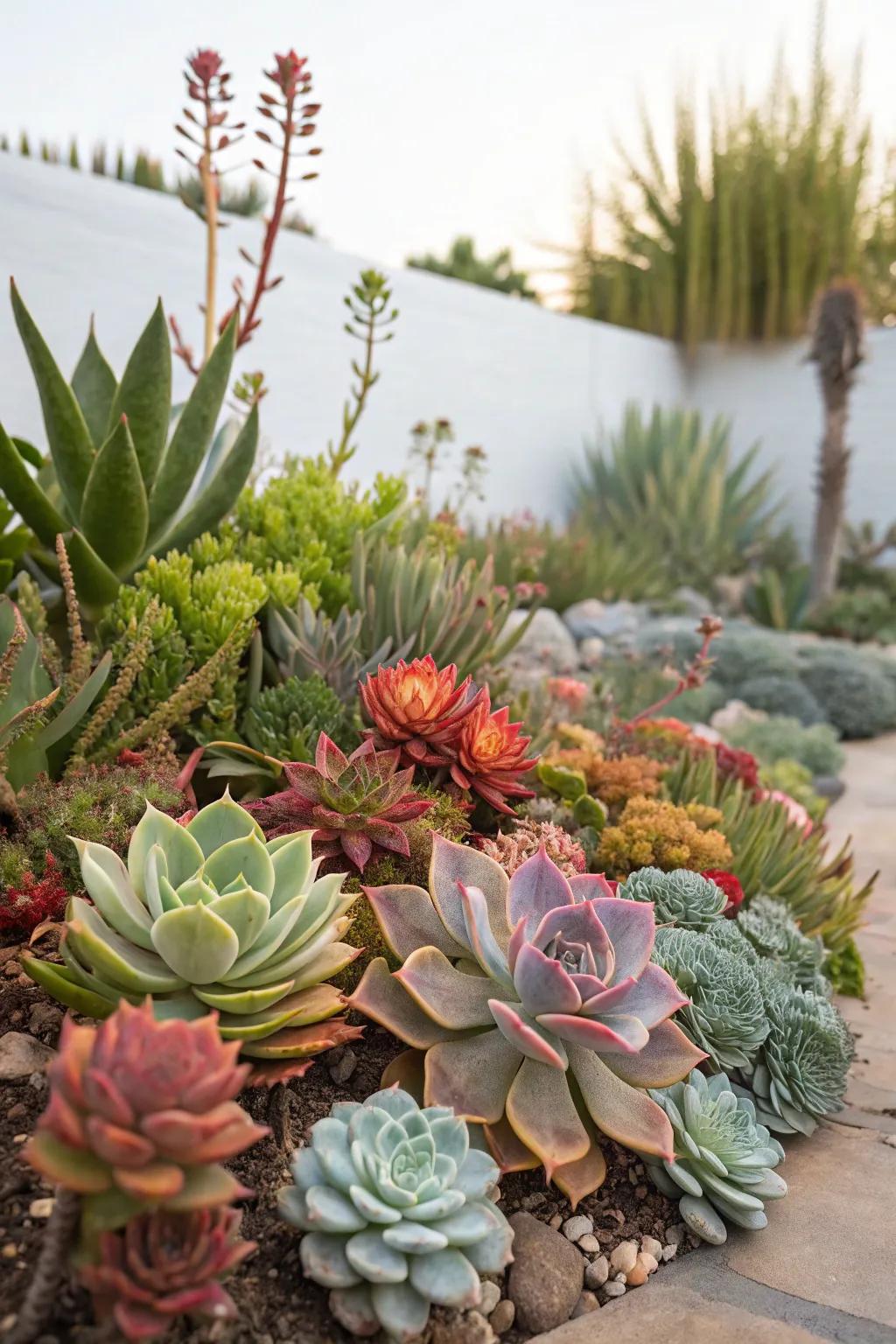
Succulents are the ultimate drought-tolerant plants, perfect for adding texture and color. They’re a staple in my garden, offering diverse shapes and hues without demanding constant watering.
Give these a look:
- Assorted Succulent Plant Collection: Bring vibrant life to your garden with varied, easy-to-grow succulent plants.
- Decorative Gravel for Succulents: Enhance your succulent garden’s appearance with stylish, moisture-preserving decorative gravel.
- Succulent Potting Mix: Ensure optimal growth for succulents with a high-quality, well-draining potting mix.
9. Try Raised Planters
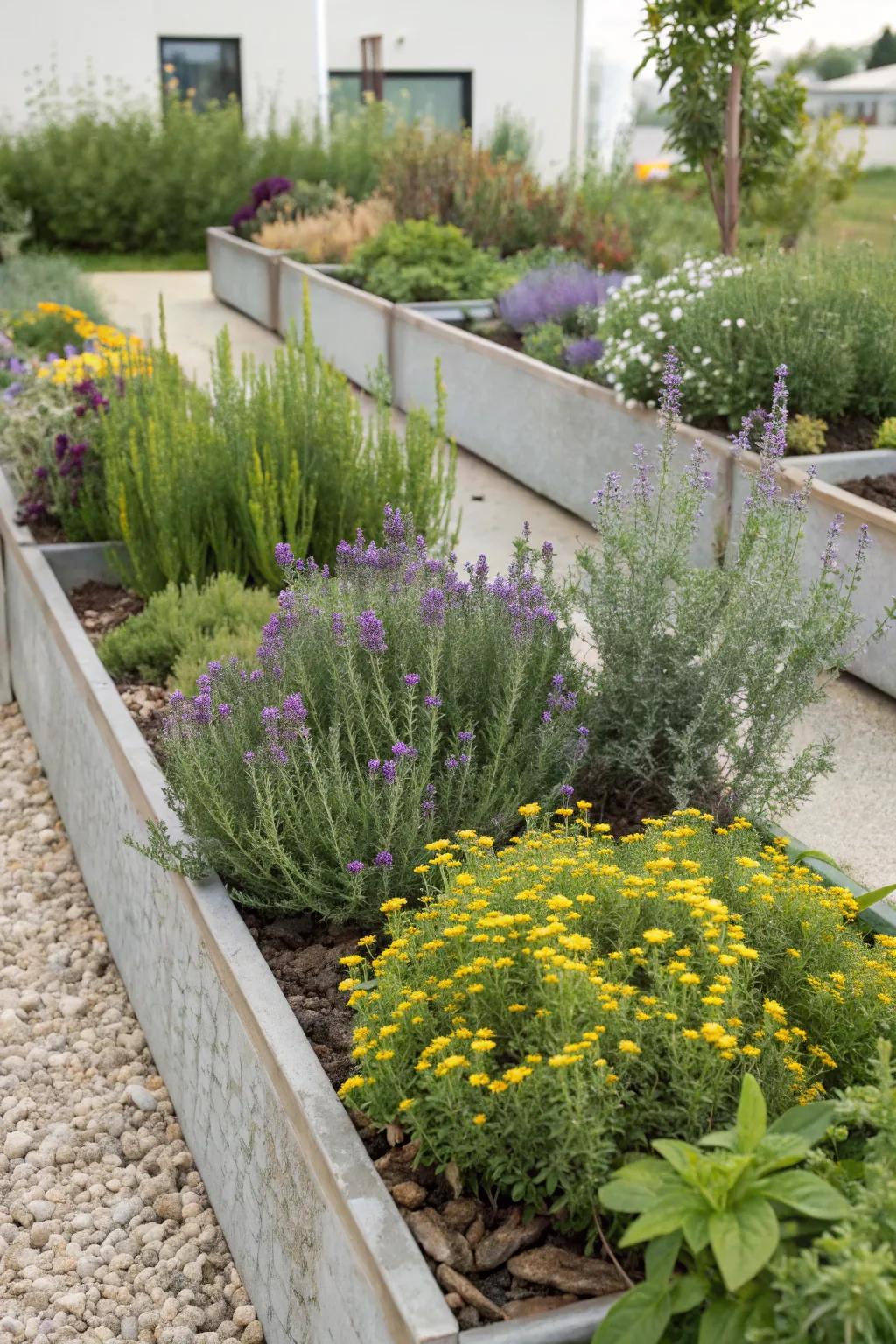
Raised planters can help manage water use efficiently and add depth to your garden. In my yard, they house a mix of herbs and small flowers.
Some handy options:
- Metal Raised Garden Bed: Enhance your garden with a durable raised metal bed, perfect for herbs and small flowers.
- Gardening Tool Set: Equip yourself with essential tools for maintaining your raised planters with ease and efficiency.
- Organic Herb Seeds: Start your raised planter with a variety of herb seeds tailored for efficient water use.
10. Design a Dry Creek Bed
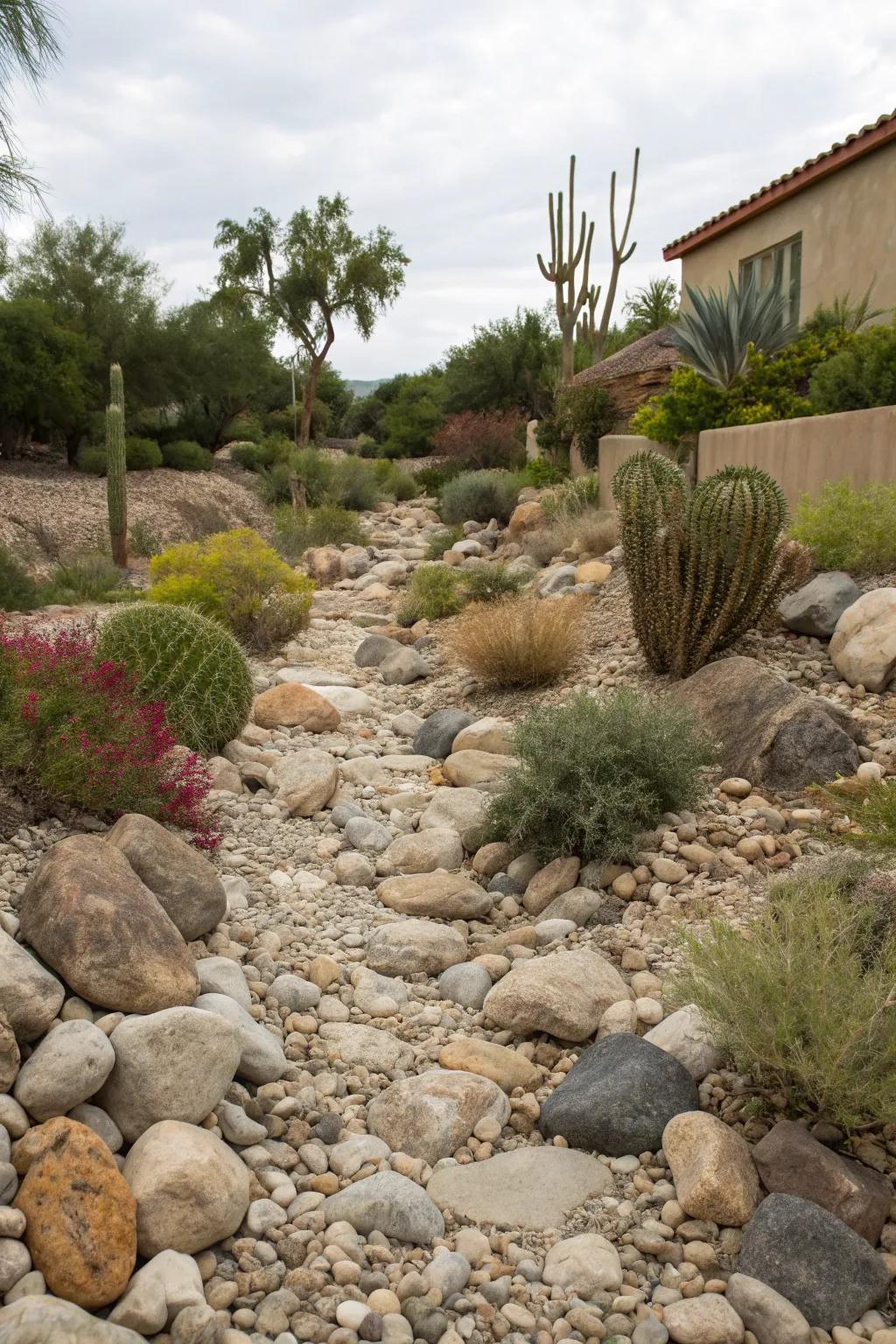
A dry creek bed adds visual drama and guides rainwater efficiently. It’s a stunning feature in my garden that mimics a natural waterway.
May just do the trick:
- Decorative River Rocks: Enhance your dry creek bed with natural river rocks. Create stunning textures and visual appeal.
- Landscape Fabric: Use landscape fabric to control weeds and ensure proper drainage in your dry creek bed.
- Drought Tolerant Plants: Add color and resilience with drought tolerant plants. Perfect for a sustainable dry creek bed.
11. Collect Rainwater
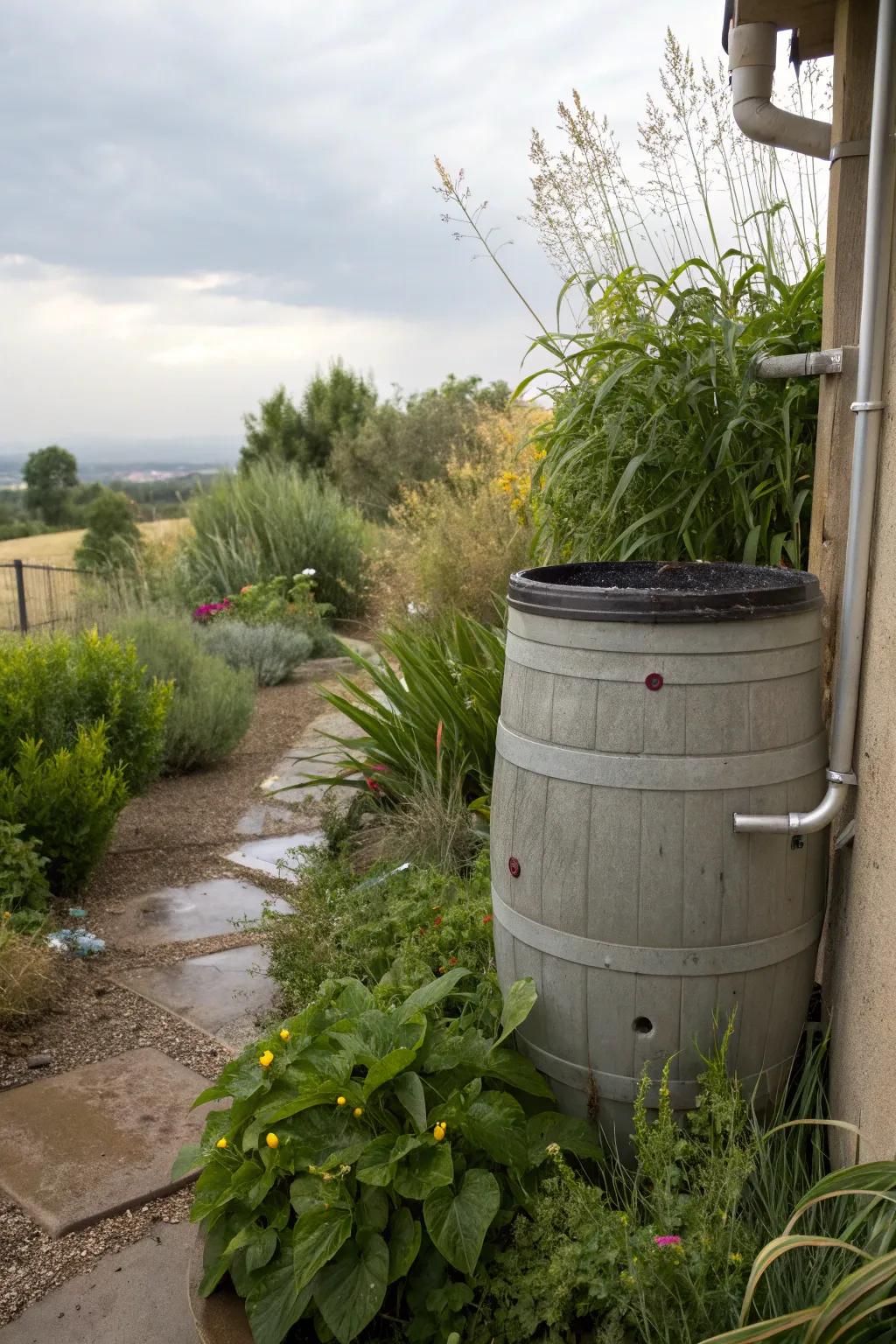
Installing a rain barrel is an easy way to conserve water for your garden. My rain barrel keeps my plants hydrated through dry spells without tapping into the water mains.
Might be a good match:
- Rain Barrel: Install a rain barrel to easily store water and keep your garden lush during dry spells.
- Rain Barrel Diverter Kit: Use a diverter kit to smoothly direct rainwater from your gutters into the barrel.
- Gutter Extension Hose: Attach a gutter extension hose to ensure optimal rainwater collection into your storage barrel.
12. Install a Zen Garden

A Zen garden with sand and stones offers tranquility and minimal maintenance. It’s my go-to spot for meditation and reflection.
Check if these fit your needs:
- Zen Garden Sand: Enhance tranquility with premium sand, perfect for creating soothing patterns in your Zen garden.
- Decorative Zen Stones: Add harmony with assorted decorative stones to accentuate the beauty of your Zen space.
- Bamboo Rake Set: Craft perfect patterns with a bamboo rake set designed for meticulous Zen gardening.
13. Use Mulch for Moisture Retention
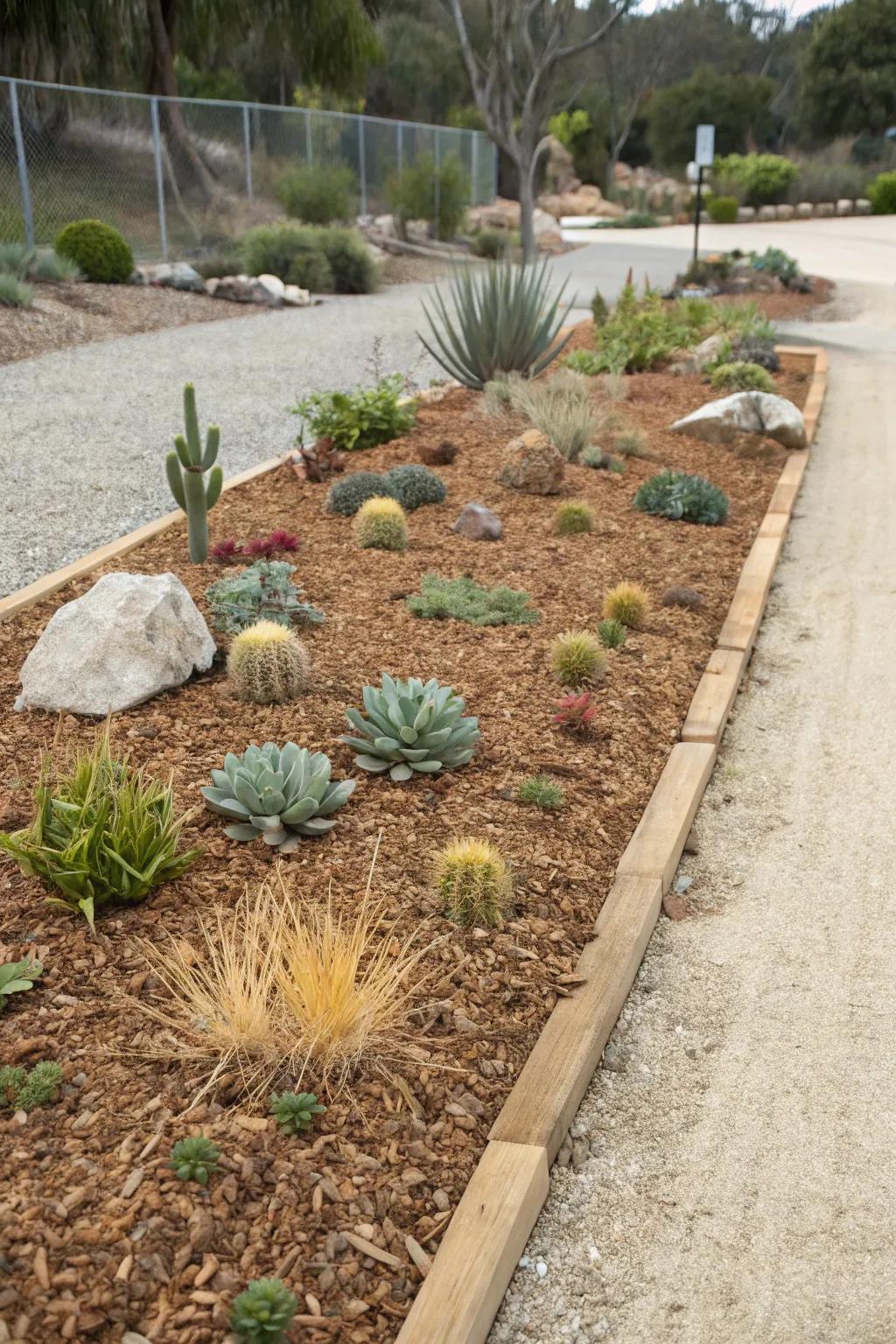
Covering soil with mulch helps retain moisture and suppress weeds. I’ve found it incredibly useful in keeping my plants healthy during the hot Texas summers.
Useful items to consider:
- Organic Cedar Mulch: Enhance your garden’s moisture retention and reduce weeds with aromatic organic cedar mulch today.
- Colored Hardwood Mulch: Brighten your landscape and support moisture conservation with vibrant colored hardwood mulch.
- Rubber Mulch Nuggets: Invest in sustainable rubber mulch nuggets to maintain soil moisture and suppress weeds effectively.
14. Choose Ornamental Grasses
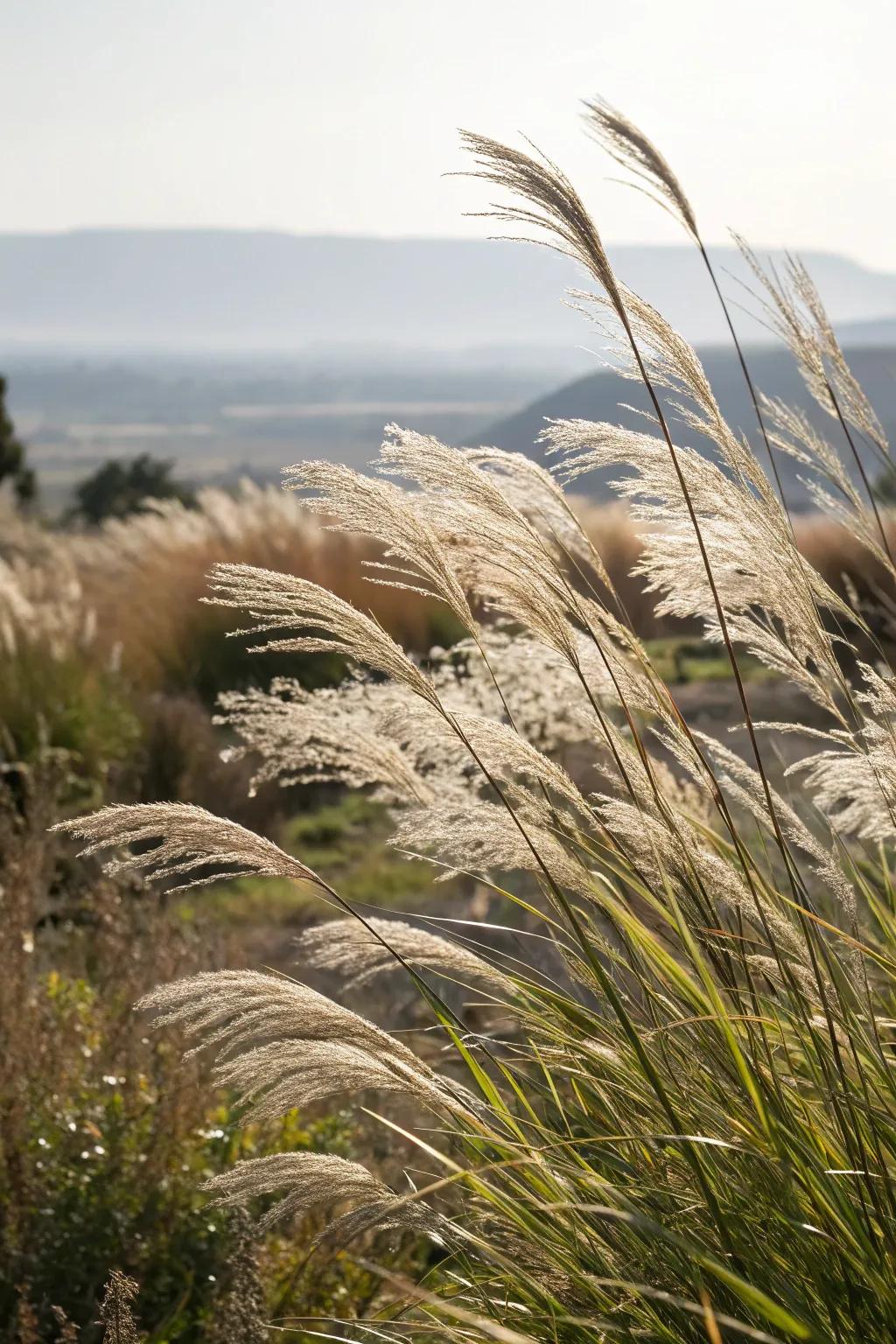
Ornamental grasses bring movement and elegance to your garden with minimal water needs. They dance beautifully in the breeze, creating a dynamic landscape.
A few choices to try:
- Ornamental Grass Seed Packets: Add vibrant variety to your garden with easy-to-grow ornamental grass seed packets.
- Decorative Garden Mulch: Enhance your garden’s appeal with decorative mulch, ideal for ornamental grass surroundings.
- Stainless Steel Garden Edging: Maintain clean lines in your garden with durable stainless steel edging for ornamental grasses.
15. Select Native Plants
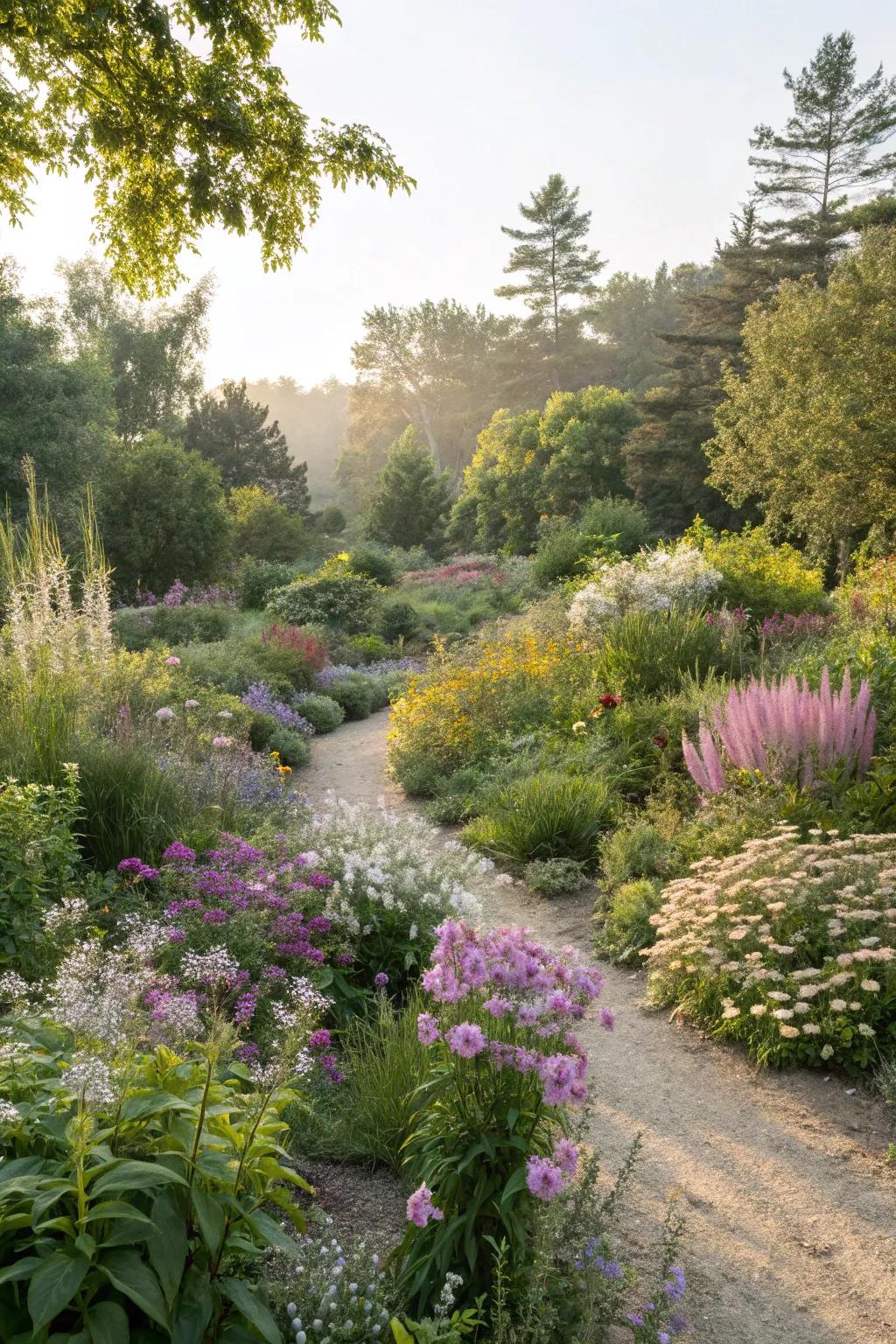
Native plants are adapted to local conditions, making them water-wise choices. They’ve become my garden’s backbone, thriving with minimal care.
Products that could assist:
- Native Plant Garden Seeds Pack: Cultivate a stunning garden with minimal water using native plant seeds. Enhance biodiversity effortlessly.
- Drought-Tolerant Plant Collection: Transform your landscape with drought-resistant plants; enjoy beauty with reduced watering needs.
- Organic Fertilizer for Native Plants: Nourish your native plants with organic fertilizer. Promote sustainable growth and vibrant blooms.
16. Incorporate Water Features
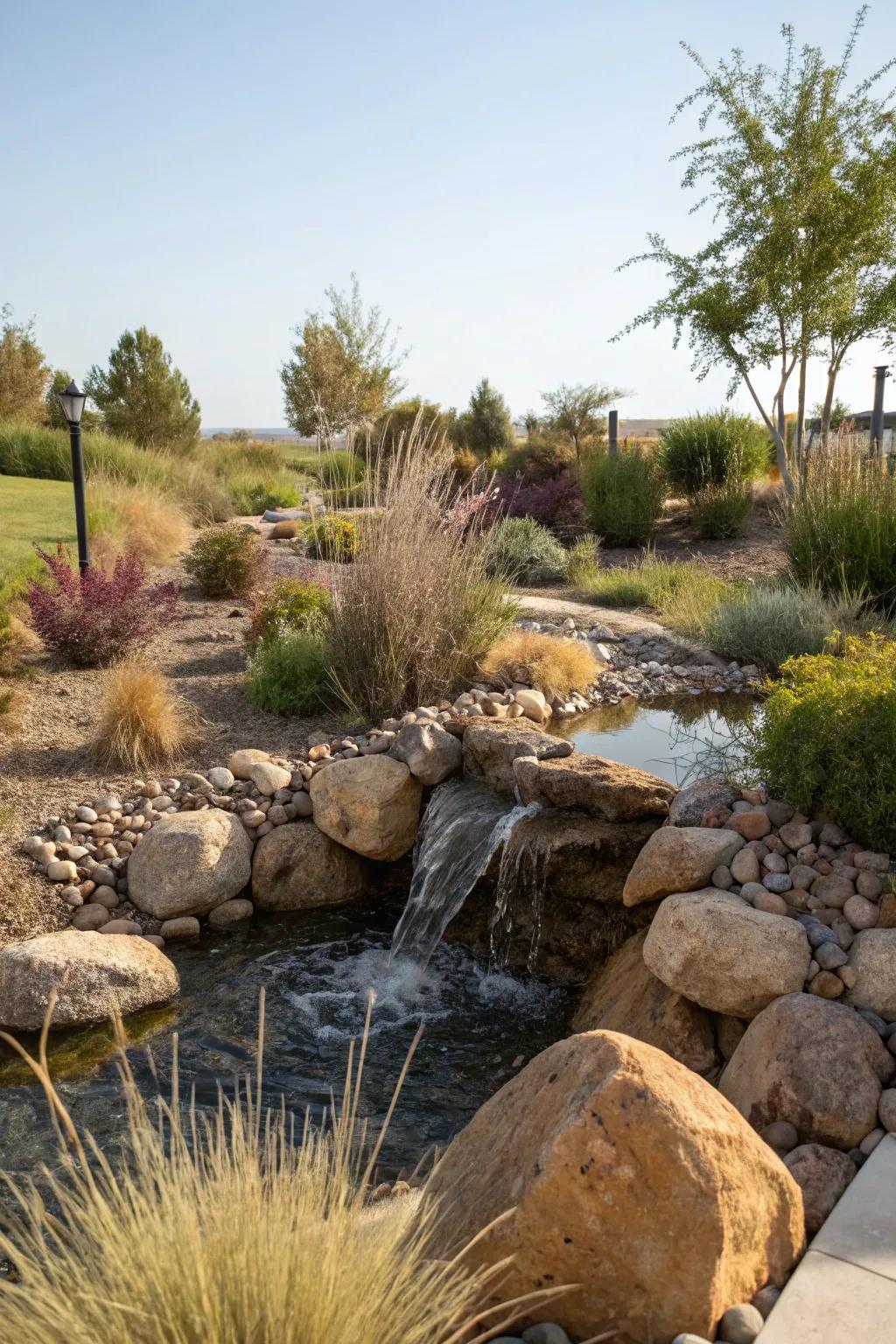
Opt for a low-maintenance water feature like a bubbling rock. It adds soothing sounds and visual interest without a significant water commitment.
Items that may come in handy:
- Bubbling Rock Fountain Kit: Transform your garden with a bubbling rock fountain, adding tranquility and beauty effortlessly.
- Solar Water Pump for Garden: Use a solar water pump for an eco-friendly bubbling rock, reducing energy consumption effectively.
- Low Maintenance Pond Liners: Install a durable pond liner to ensure your water feature is easy to maintain and long-lasting.
17. Use Ground Covers
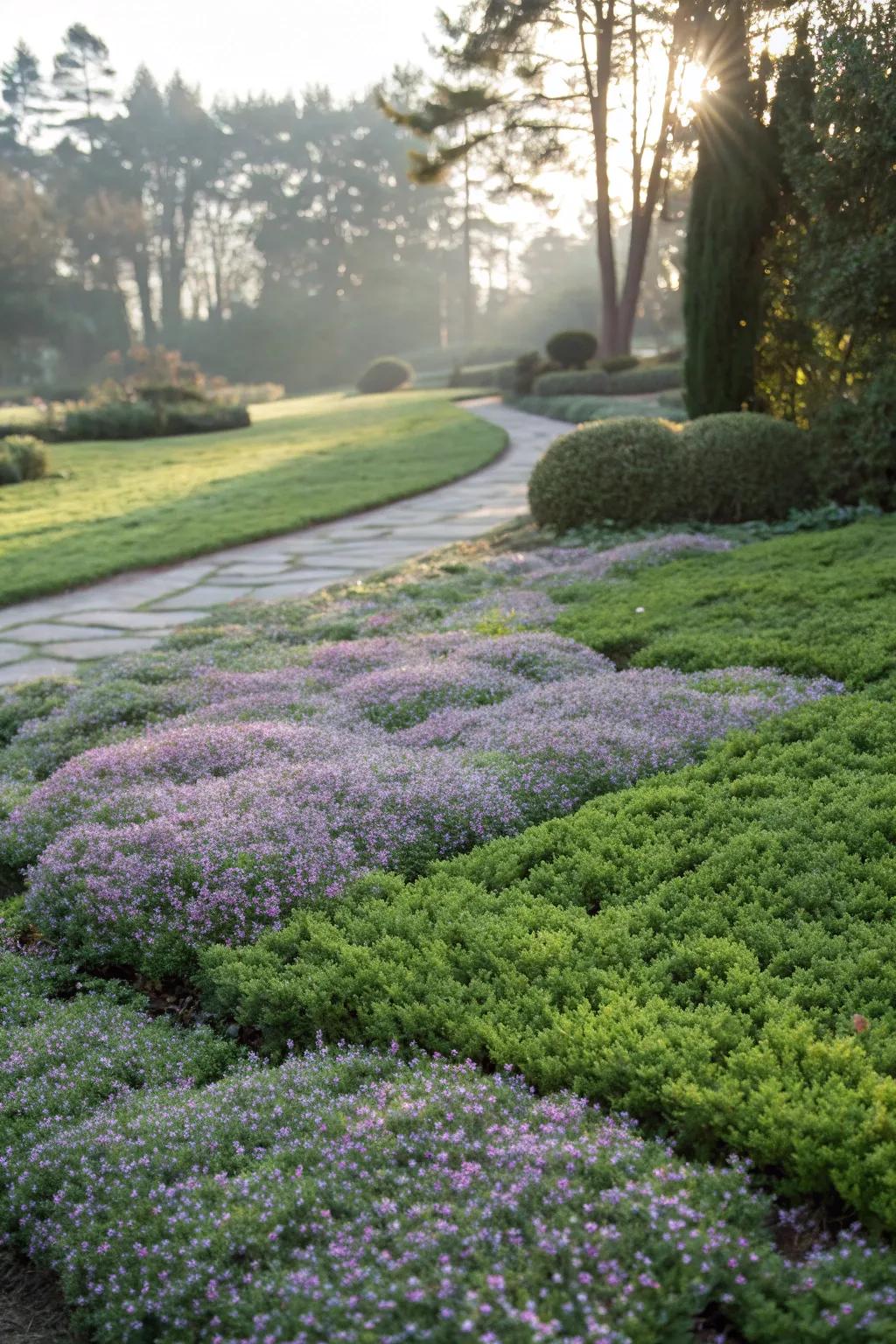
Ground covers like creeping thyme reduce water needs and add lushness. They’ve replaced my grass, creating a soft, green carpet.
Check these products out:
- Creeping Thyme Seeds: Transform your lawn with drought-tolerant creeping thyme seeds. Create a lush, green carpet easily.
- Garden Soil Mix for Ground Covers: Enhance your ground cover growth with nutrient-rich soil mix designed for thriving landscapes.
- Ground Cover Planting Tool Set: Effortlessly plant your ground covers with a specialized tool set for precise gardening.
18. Add a Living Wall
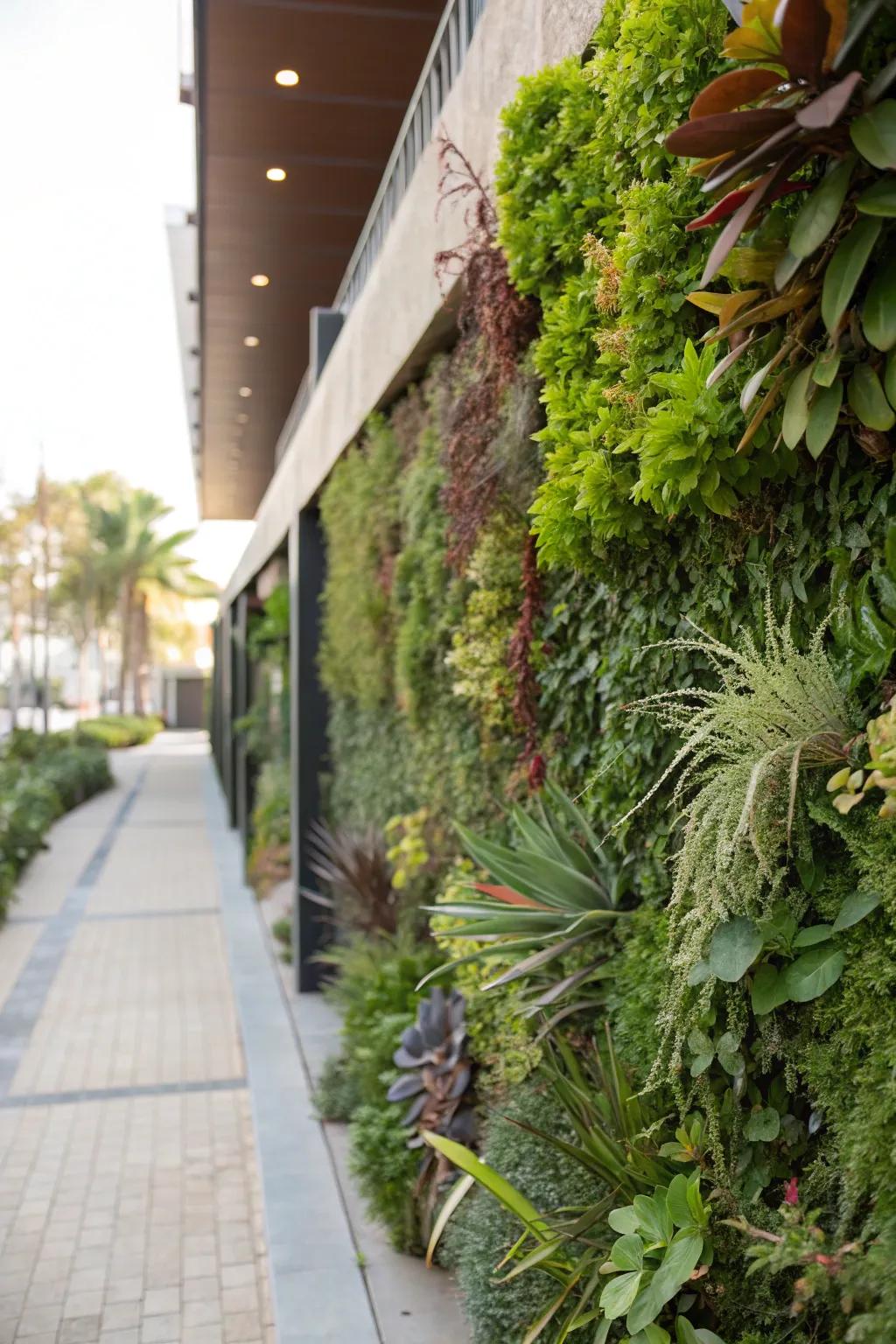
A living wall can create a lush vertical garden with minimal ground space. I find it a delightful way to showcase my favorite succulents and ferns.
These products might help:
- Vertical Wall Planter System: Transform your space with this modular planter for an easy, stunning vertical garden.
- Self-Watering Wall Planters: Ensure vibrant greenery with minimal effort using these efficient self-watering planters.
- Succulent Potting Mix: Enhance plant health with this tailored soil mix perfect for your succulents.
19. Create Shade with Pergolas
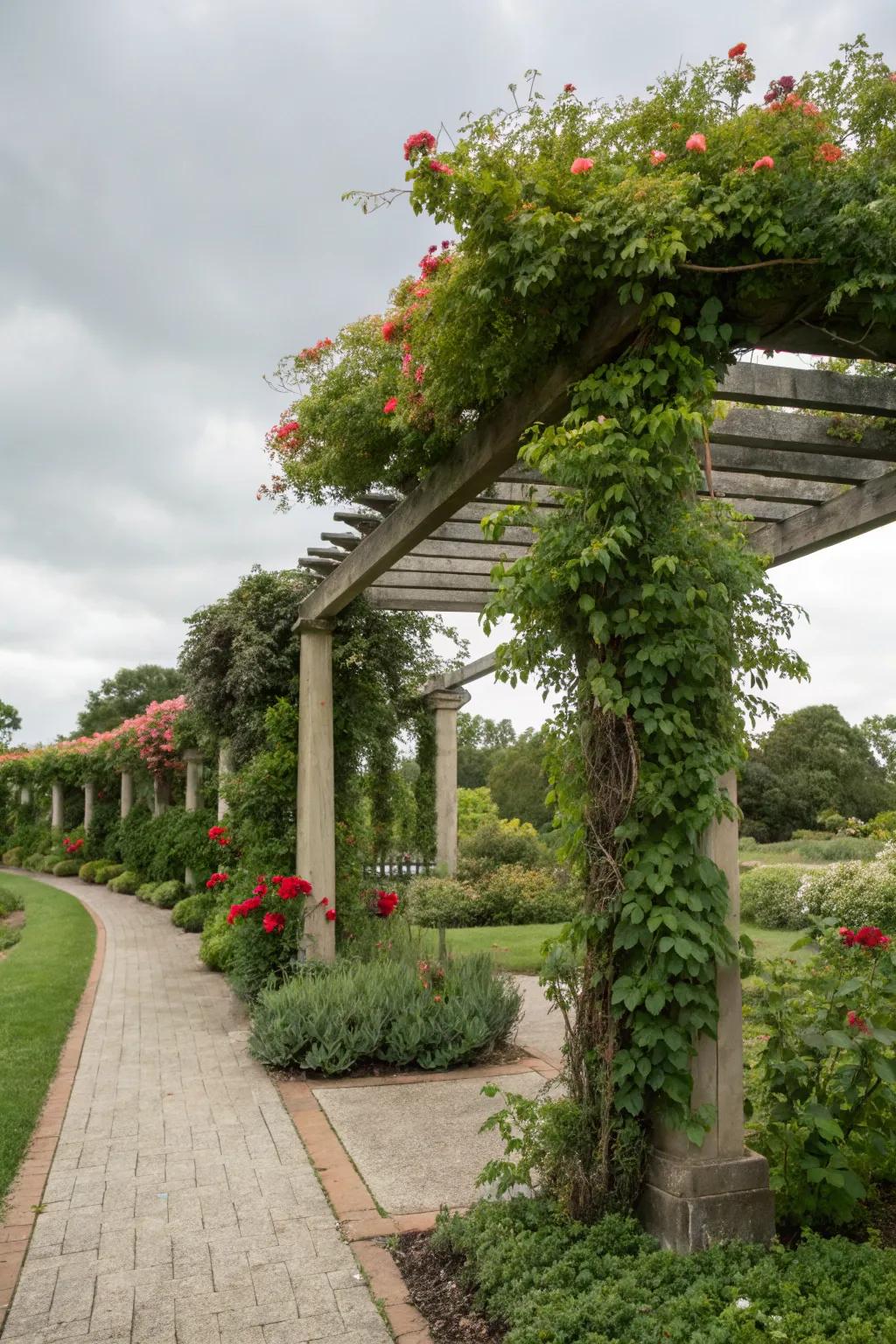
A pergola provides shade and supports climbing plants. It’s a favorite spot in my backyard for escaping the midday sun.
Consider these options:
- Garden Pergola Kit: Assemble this pergola kit to create a stylish, shaded retreat in your garden effectively.
- Climbing Plants for Pergola: Transform your pergola with vibrant climbing plants, adding natural beauty and shade instantly.
- Outdoor String Lights: Add charm and ambiance to your pergola with these durable, weather-resistant outdoor string lights.
20. Frame with Hedges
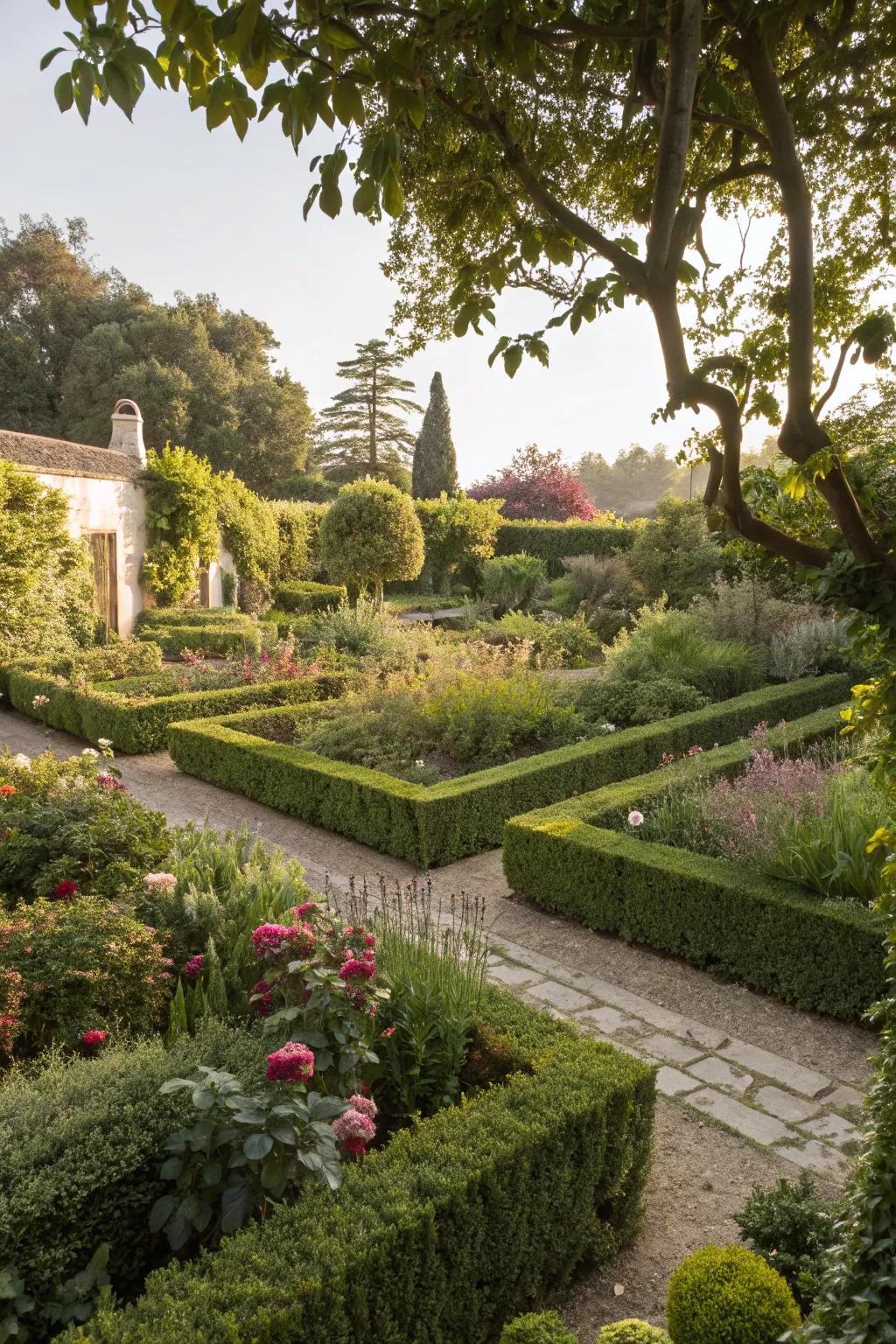
Drought-tolerant hedges offer privacy and structure. In my garden, they’ve become natural green walls, giving a sense of enclosure.
Possibly handy products:
- Drought-Tolerant Hedge Plants: Enhance your garden with beautiful drought-tolerant hedge plants, providing privacy and structure effortlessly.
- Self-Watering Planters: Ensure your hedges thrive with minimal water effort using self-watering planters. Simplify your garden care!
- Organic Mulch for Gardens: Conserve moisture and maintain soil health with organic mulch, perfect for sustaining your hedges.
21. Explore Vertical Gardening
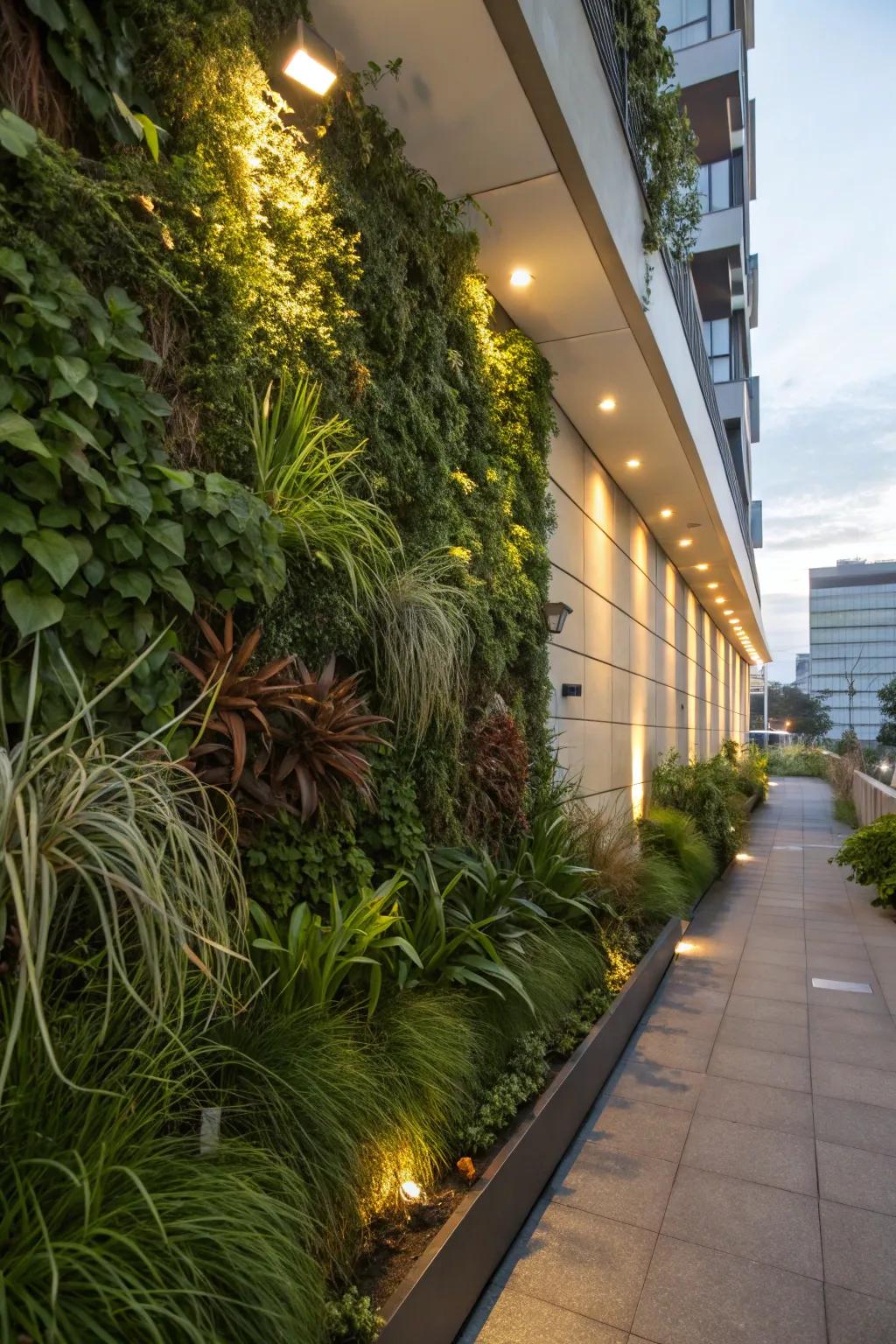
Vertical gardens maximize space and water efficiency. They’re perfect for small areas, offering an innovative way to green up walls.
These products might be useful:
- Vertical Wall Planter: Transform your wall into a lush garden with an efficient and stylish vertical wall planter.
- Automatic Drip Irrigation Kit: Ensure your vertical garden stays hydrated with a convenient automatic drip irrigation kit.
- LED Grow Light Strips: Enhance plant growth in dim areas with energy-efficient LED grow light strips.
